Intro to Psych pt. 2
1/242
There's no tags or description
Looks like no tags are added yet.
Name | Mastery | Learn | Test | Matching | Spaced |
|---|
No study sessions yet.
243 Terms
questions associated with cognititve psych
how do we learn from our environment?
how do we remember what we’ve learned?
how do we think about and interact with the world around us?
how do we communicate?
what does one’s social environment impact?
brain → cognition → behavior
what is learning? (behaviorism)
associations between events
if event A occurs, event B will occur
two types of associative learning
classical conditioning: stumulus A → stimulus B (think dog)
operant conditioning: behavior → consequence (think rats)
classical conditioning
a neutral object elicits a response when it is associated with a stimulus that already produces that response (Pavolov’s dog)
components associated w classical conditioning
unconditioned stimulus
unconditioned response
neutral object
conditioned stimulus
conditioned response
Pavlov’s dog
salivated when the bell was rung
step 1 of classical conditioning
unconditioned stimulus (US) → unconditioned response (UR)
dog food bowl → dog salivating
automatic response
step 2 of classical conditioning
take a neutral stimulus (something that does not naturally ilicit a response)
metronome → no response in dog
step 3 in classical conditioning
pair the neutral stimulus and pair it with the unconditioned stimulus
timing and order of events is critical to learning
metronome + food bowl
step 4 in learning
neutral stimulus becomes the conditioned stimulus (CS) and elicits a conditioned response (CR)
metronome will now cause dog to salivate
what does classical conditioning look over time?
as time goes on, the more pairings there are between the CS + US = acquisition
the association (metronome with salivating) does not last forever (can also be unpaired) = extinction
acquisition
the CS-US pairings lead to increased learning. as a result, the CS can produce the CR
extinguish
if the CS is presented without the US, eventually the CR extinguishes
stimulus generalization
the new conditioned stimulus (CS) is generalized to similar stimulu
one dog bag (CS) generalized to other dog food bags
stimulus discrimination
formed through extinction → essentially narrow down the class of things that the conditioned stimulus includes
ex → yellow bags of dog food, but not yellow box of cheerios
high-order conditioning example
pantry → dog bowl → dog food bag → dog food → dog salivating
conditioned stimulus can be from …
any sensory modality: sight, sound, smell, etc
what are every day examples of classical conditioning?
advertising
music preferences → positive associations with particular songs or artists expands to the entire genre
tv/movie reboots
college course or major selection
application of classical conditioning
anxiety-related clinical disorders (phobias or PTSD)
fear conditioning
classically conditioning fear to neutral objects
how to treat fear conditioning
extinguish the association between the stimulus and fear
counterconditioning: exposing a patient to small doses of the feared stimulus while engaging in an enjoyable task
systematic densensitization: slowly increasing a patient’s exposure to the feared stimuli
operant conditioning
the link of behavior → consequence
behaviors change because they have been reinforced or punished
terms of operant conditioning
positive reinforcer
negative reinforcer
positive punishment
negative punishment
reinforcement (positive or negative)
increases the likelihood of behavior
ex → if we want a rat to press a lever, we will either reward w food when pressed or take away a shock when pressed
positive reinforcement
the addition of a stimulus to increase behavior
example: giving food every time button is pressed
negative reinforcement
the removal of a stimulus to increase behavior
example: press button to remove shock
punishment (positive or negative)
reduces the likelihood of behavior
ex → we don’t want the rat to press the lever, so we take away food or deliver a shock
positive punishment
the addition of a stimulus to reduce behavior
example: pressing a button adds a shock
negative punishment
the removal of a stimulus to reduce behavior
example: pressing a button removes food
four quadrants of operant conditioning
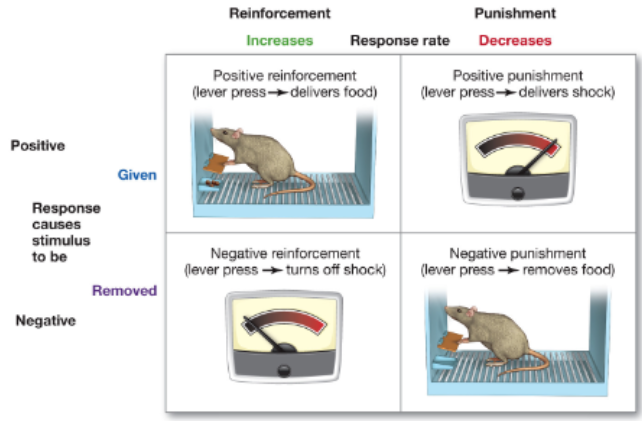
categories of reinforces and punishers can be…
broadened or narrowed by stimulus generaliztion or discrimination
T of F: timing of reinforcement or punishment is critical
T
continuous schedule
actions always lead to consequences
intermittent schedule
actions sometimes lead to consequence (most effective way of operant conditioning)
example of intermittent schedule
gambling
what are every day examples of operant conditioning?
obedience training (‘shaping’ behaviors)
parenting behaviors
school grades → good grades reinforce your studying behaviors for the future, bad grades may lead you to change studying behaviors
gambling
mental health link to operant conditioning
autism-spectrum disorders
→ applied behavior analysis (ABA therapy) → identify a reinforcer (specific activity, object, etc) → provide the reinforcer whenever a child engages in desired behavior → remove the reinforcer whenever a child engages in negative behavior
when is ABA therapy used
used to improved social, language/communication, and cognitive behaviors
difference between classical and operant
think of classical as involuntary/automatic and operant and voluntary
initial proposal of associative learning
any two paired events will produce a learned assocaition
classical conditioning: any stimulus A → any stimulus B
operant conditioning: any behavior A → any outcome B
biological prepardness of learning
not all CS-UR pairings are associated equally well
pairing stimuli close in time is not always suffiecient to create learning
certain pairings of stimuli are more likely to become associated than others → conditioned taste aversion: the association between eating a food and getting sick → difficult to pair non-food stimuli with nausea
‘built-in’ fear detectors
more likely to fear snakes than flowers
more likely to form negative associations with out-group memories
more likely to find threatening things in your environment (pictures of snake among flowers and vice versa)
operant conditioning for biological prepardness
animals have difficulty learning associations tht run counter to their natural behavioral responses
conditioning is most effective when the association between the behavior and the reinforcement is similar to the animal’s built-in prepardness
more likely to train a rooster to peck to get food and to fly away to avoid shock than the opposite
given a 24 hour rest after the extinction of a controlled stimulus…
if the CS is presented alone, it will produce a weak CR, known as spontaneous recovery
given a 24 hour rest after spontaneous recovery…
this CR gets weaker and will extinguish if the CS is continually presented alone
latent learning
animals can also learn without reinforcement (mice learning mazes)
outcome of rats and latent learning
the third group actually learned something over the past 10 days, despite it not showing
distinction between competence (knowing how to do a task) and performance (actually completing the task)
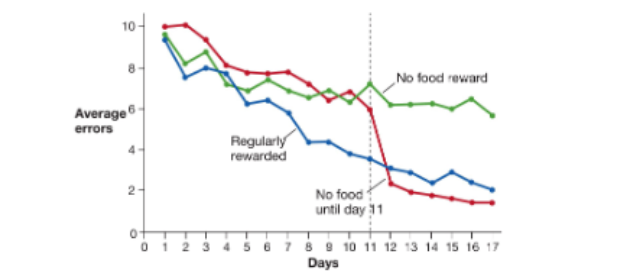
social-congnitive learning
observational learning (learning by watching others) makes learning more efficient → do not need first-hand experience with all associations (vicarious learning)
the social world is a strong…
higher-order reinforcer → we are highly motivated to imitate other’s actions
vicarious learning
we do not need first-hand experience with all associations
bandura’s bobo doll study
vicarious learning
child watches adult beating on a clown doll, and they did the same
same study was conducted years later but with television → early study of the link between television violence and real life violence
how did akira memorize 100,000 digits of pi?
he turned each digit into an idea and put them together to create a “story”
what is memory?
the capacity to encode (gathering information), retain (storage), and retrieve (pulling out) information
encoding
brain changes information into neural code
memory is the…
result of brain activity
variables that affect encoding/how well info sticks
level of processing model
more deeply an item is encoded → better it is remebered
the levels of the processing model
shallow processing, intermediate processing, deep processing
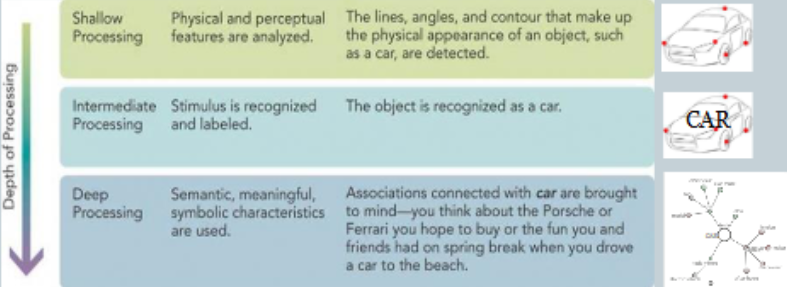
shallow processing
physical and perceptual features are analyzed
intermediate processing
stimulus is recognized and labeled
deep processing
semantic, meaningful, symbolic characteristics are used
deeper processing →
greater brain activity
storage
brain stores information through consolidation
memory consolidation
process by which a long-term memory becomes durable and relatively stable
structural changes in the brain when information is become consolidated
Long-term potentiation (LTP)
T of F: Memory Consolidation happens better during wakeness than sleep
F
Long-term potentiation (LTP)
strengthening of connections between neurons
caused by repeated stimulation over time
long-lasting increase in signal transmission between neurons
dendrites can grow, synapses increase, synapses strengtehn
memories are...
NOT stored in one specific part of the brain; they are distributed throughout the cortex
distributed memory
sights, sounds, smells stored in different brain regions
memories organized as assemblies (groups) in the brain
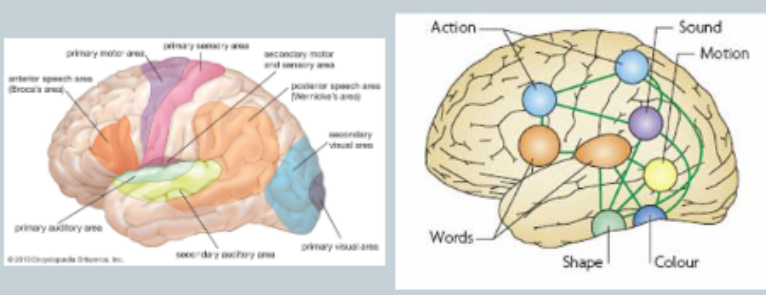
association networks
organize information in memory
similar concepts connected through their associations
retrieval
stored information reactivated
memory retrieval
reactivation of sensory information present at encoding
study regarding memory retrieval
presented with picture + word or sound + word
later, ONLY given the word and asked to either recall the image or the sound
the same regions of the brain were active (visual or auditory cortex) as when they first learned the infromation
many types of forgetting are failures of…
retrieval
what can be used to help access information in long-term memory?
retrieval cues
encoding context can serve as a retrieval cue
context-dependent memory → if you can remember the context, you can be pointed to what you’re trying to remember
context-dependent memory study
scuba divers learning words on land vs. underwater → able to recall better in the environment where they studied
happy memories are easier to retrieve when a person is…
happy → mood congruent memory
memory systems differ in terms of…
duration and capacity
how are memories maintained over time
sensory input → sensory memory + attention → short-term memory + encoding → long-term memory
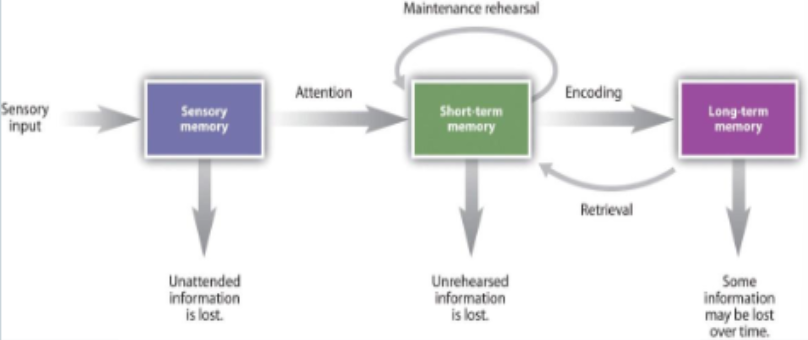
memory systems → duration
sensory memory → fraction of a second to several seconds (think of fireworks)
working memory/short-term memory → up to 30 seconds (think of holding onto a phone number)
long-term memory → up to a lifetime
sensory memory
entryway to memory
very brief
information quickly lost if not passed to short-term memory
short-term memory
retains information for short-periods (5-30)
limited capacity (can hold 5-9 items at one time)
magic number 7 [digits]
chunking
organizing information into meaningful groups
limited capacity can be increased by chunking
long-term memory
long-term storage of information
no known capacity limits
relatively enduring
primacy effect
people have a good memory for items at the beginning of the list (long-term memory)
recency effect
people also have a good memory for items at the end of the list (short-term memory)
we know there are different long-term memory systems because of…
removal —> think patient HM
patient HM
had epilepsy, removing the hippocampus bilaterially significantly reduced his seizures, but he had an inability to form new memories —> information can’t stick anymore —> this procedure is still done, but not bilaterially
severe anterograde amnesia
temporally graded retrograde amnesia
can still remember motor skills —> how to ride a bike, play a piano
can learn conditioned responses
can remember facts (paris is the capital of france)
medial temporal lobe damage
medial temporal lobe amnesia
anterograde amnesia, retrograde amnesia

anterograde amnesia
inability to form new memories for new information encountered after brain damage
retrograde amnesia
loss of old memories for information encoded before brain damage
lonnie sue
an artist left with profound amnesia after suffering from encephalitis which caused damage to the hippocampus
areas of “spare knowledge” —> not an empty shell, despite not remembering many things from her past
types of long-term memory storage
explicit memory (declarative) and implicit memory (nondeclarative)
explicit memory (declaratitve)
requires conscious effort and often can be verbally described
—> “my father died last year”
episodic memory (personally experienced events), semantic memory (facts and knowledge)
implicit memory (nondeclarative)
does not require conscious effort and often cannot be verbally described
—> riding a bike, tying shoes
classical conditioning, procedural memory, reflexes
intact implicit (non-declarative) memory in patients with MTL damage
when a tone happens, a puff of air into the eye is administered, causing the patient to blink —> CS (tone) elicits CR (blink) aka patient starts to blink immediately when the tone is heard
tracing within lines by looking into mirror —> patients have no memory of prior sessions, but they get better/make less mistakes with each session
episodic memory
autobiographical: “I remember”
tagged with spatial and temporal context
“What did you have for breakfast this morning?”
associated with the medial part (hippocampus) of temporal lobe
semantic memory
factual: “I know”
not necessarily tagged with a context
“Name a food typically eaten for breakfast”
associated with the underneath part and anterior part of temporal lobe
semantic dementia
“confused concepts”
damage to the underneath part and anterior part of temporal lobe
progressive neurodegenerative disorder
characterized by loss of semantic memory
“I went to the restaurant and ate…that thingy…”
semantic dementia patient
could use the different objects, but not associate the correct names with them
semantic dementia animal drawings
common animal properties preserved (eyes, tails)
unusual properties omitted (hump of camel, flippers of seal)